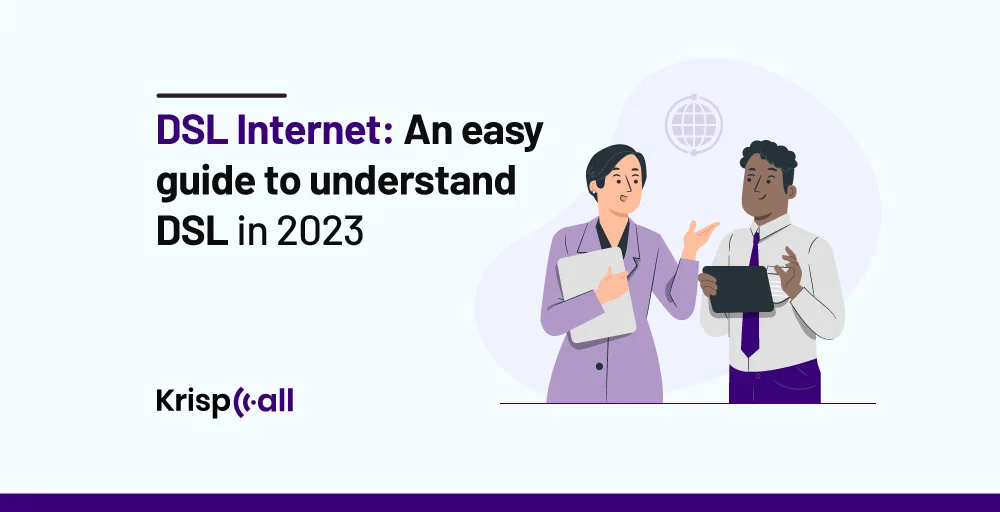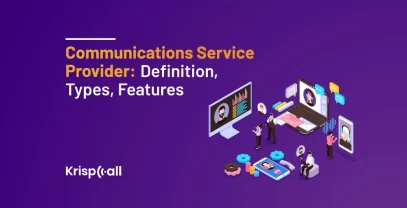Are you frustrated by slow internet speeds and buffering when you try to Surf the internet? Are you tired of feeling like you’re stuck in the slow lane of the information superhighway?
Get ready to boost your online experience with DSL (Digital Subscriber Line) Internet. It’s time to let go of buffering and enjoy lightning-fast internet speeds
In this blog, we’ll reveal the mysteries of DSL and equip you with the knowledge you need to maximize your internet connection. From how it works to its benefits, limitations, and best providers, we’ve got you covered.
Without wasting any time, let’s get started!
What is DSL Internet? How does it work?
DSL internet is a high-speed internet that is connected through WIFI or an ethernet cable through a modem.
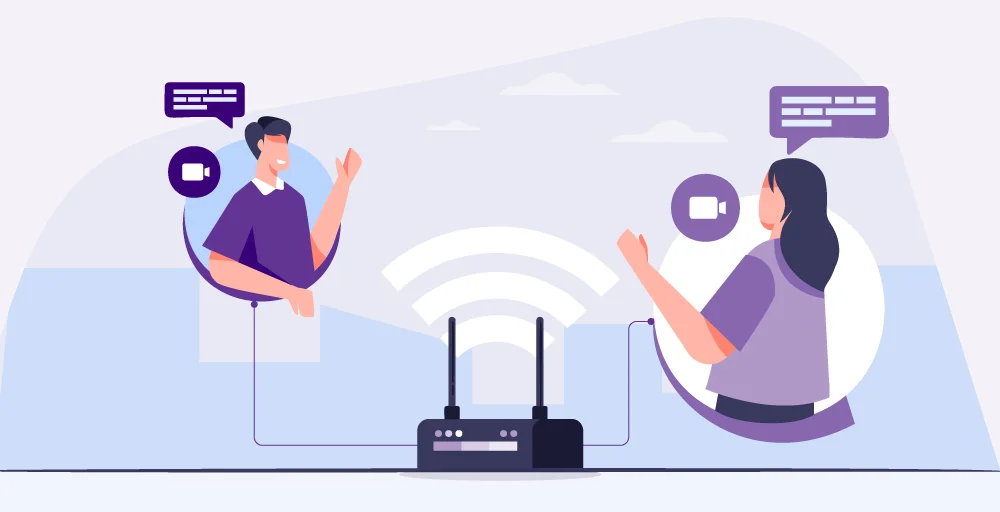
DSL stands for Digital Subscriber Line/Loop, a communication medium that receives data via copper wire telephone landline.
DSL is the primary form of broadband internet access, using existing telephone wiring to transmit data. It makes internet accessible to all, and it is generally best for high-speed downloads.
In DSL modems, signals are collected through telephone lines and transformed into digital data for your use. You can access this data wirelessly or via an ethernet cable. Since existing telephone lines are used, DSL is available and can be used in rural and urban areas.
Telephone wires have much more capacity than carrying phone conversations, so DSL signals are easily carried by the same wires. It is a cost-effective method for a fast internet connection, with speeds ranging from 256 Kbps to 100 Mbps.
What are the different types of DSL Internet?
There are 4 types of DSL internet, let’s have a brief overview of them:
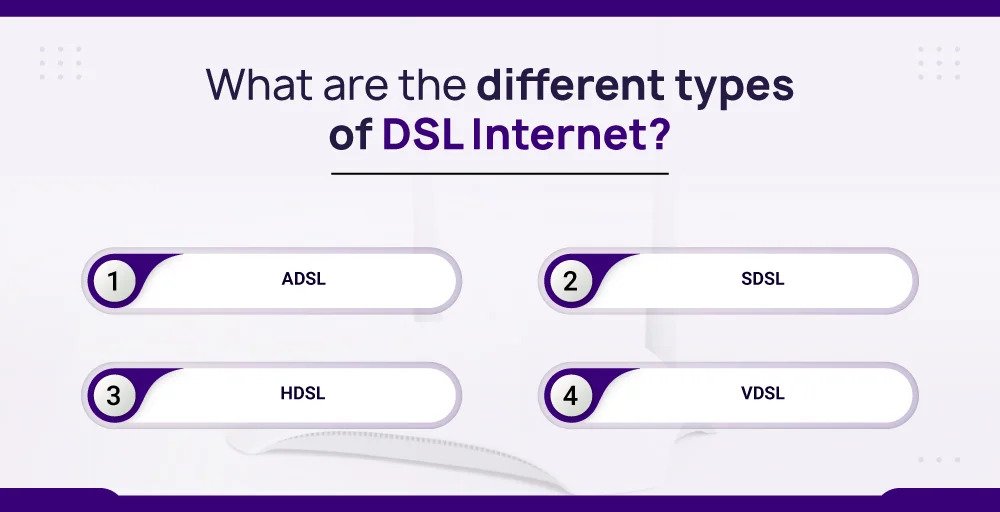
- ADSL: Asymmetric DSL has higher download speeds. It is called asymmetric because it has different uploads and download speeds. Upload speeds are up to 1.4 Mbps, and download speeds are up to 20 Mbps. Upload speeds are lower to focus on higher download speeds.
- SDSL: Symmetric DSL balances upload and download bitrates by dividing the incoming and outgoing frequencies equally. It provides T1 speeds (1.54 Mbps) over distances up to 10,000 feet, making it more suitable for corporate offices.
- HDSL: High-bit-rate DSL is a symmetric DSL technology that transmits data over two copper twisted pairs at high speeds. It is commonly used for dedicated lines for businesses and has E1/T1 download speeds.
- VDSL: Very High Bitrate DSL is an advanced form of DSL that has higher data rates than ADSL and SDSL. Using extremely high frequencies, it offers download speeds of up to 52 Mbps and upload speeds of up to 16 Mbps. VDSL2 provides greater capacity (up to 100Mbps) and symmetric speed than VDSL, allowing it to be used in Triple Play (data, video, voice) environments.
DSL Vs Cable: What is the difference?
When comparing DSL and cable internet, understanding the structural differences, availability considerations, and reliability factors is crucial.
Here are some differences between them based on these factors:
Structure
- DSL: Data is transmitted over existing telephone lines. The telephone line is divided into separate channels for voice and data.
- Cable: Utilizes coaxial cables, originally designed for cable television, to transmit data. Compared to traditional telephone lines, these cables can carry more data.
Availability
- DSL: Widely available, particularly in urban and suburban areas. Availability may vary depending on the distance from the telephone company’s central office.
- Cable: It is also available in urban and suburban areas. Rural areas may have limited access to cable internet because of limited cable infrastructure.
Reliability
- DSL: It is considered reliable, with consistent performance. Nevertheless, reliability may be affected by the quality of the copper lines and the distance from the service providers.
- Cable: It can be unreliable. During times of peak usage, cable internet may slow down due to users sharing it in a neighborhood.
Speed
- DSL: The speed of DSL varies, but on average, it is slower than cable. Depending on the distance from the provider’s office, upload speeds may be slower than download speeds.
- Cable: Provides faster speeds than DSL. Speeds can vary depending on the cable infrastructure in the area. For high-speed internet, cable is often preferred, particularly for faster download speeds.
DSL VS Fiber: What are the differences?
Here’s a simplified table of differences between DSL and Fiber Internet:
| Feature | DSL (Digital Subscriber Line) | Fiber |
| Infrastructure | Uses existing telephone lines | Utilizes thin strands of glass or plastic fibers for data transmission |
| Speed | Generally lower speed, typically up to 100 Mbps for VDSL | Provides much higher speeds, especially for upload and download, ranging from 100 Mbps to 1 Gbps and beyond |
| Symmetry | Maybe asymmetric or symmetric, depending on the type | It can be symmetric or asymmetric, depending on the technology |
| Bandwidth Sharing | Shared among users in a neighborhood(bandwidth not shared) | Less susceptible to congestion; more dedicated bandwidth per user |
| Consistency | Speed may vary based on distance from the provider’s office | Consistently high speeds, less affected by distance |
| Installation | easier to install than fiber-optic, may not require professional installation | Complex installation processes often require professional technicians |
| Availability | Widely available, especially in urban areas | Availability varies; cable and fiber-optic are common in urban and suburban areas, limited compared to DSL |
| Cost | Generally more affordable | Fiber-optic plans might be more expensive, especially for higher speeds |
What are the Advantages and Disadvantages of DSL Internet?
DSL internet has both advantages and disadvantages for individuals seeking an affordable and reliable broadband connection. By doing so, they can make an informed decision regarding their internet needs.
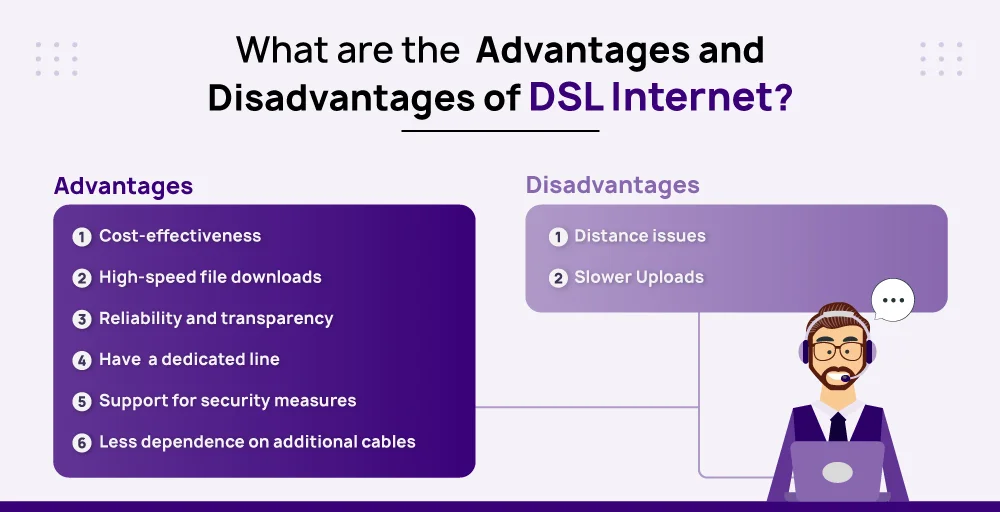
Advantages Of DSL Internet
- Cost-effectiveness
DSL is more affordable than other forms of broadband, like cable or fiber optics. It is much easier to install than those other options, making it even more affordable.
Providers don’t have usage caps on data plans, so customers aren’t charged extra if they exceed their monthly limits.
- High-speed file Downloads:
A good line can deliver speeds up to 25 Mbps, making large files, such as movies and games, very quick and easy to download. As a result, activities such as streaming music or video content online are much more enjoyable without any buffering problems.
- Reliability and Transparency
DSL signal strength is not affected by weather-like satellite connections. It provides consistent performance throughout different climates.
A distinctive feature of this service is its transparency in handling customer inquiries. If anything goes wrong, DSL companies provide detailed information regarding bandwidth availability and technical support.
- Have a Dedicated Line
Users can have their own private line without sharing bandwidth with neighbors with the same ISP. This ensures faster uploads/downloads without worrying about sudden drops in performance caused by too many people accessing the same network.
- Support for Security Measures
DSL offers greater security than cable because it offers a higher level of protection. You will typically be connected to a different network.
Multiple users often share cable-based networks, putting your privacy at risk. Additionally, total network security and safe internet access management are simplified by facilitating the deployment of security apps.
- Less Dependence on Additional Cables
DSL does not require additional cabling during installation, which requires extensive rewiring to function optimally. Your network will be set up faster and more efficiently since only one line is required.
Disadvantages Of DSL Internet
- Distance Issues
One of the major disadvantages of DSL is that its effectiveness depends on distance. Your service will become less efficient as you get further away from the DSL provider. The service may not be available if you are more than 18,000 feet from the provider.
- Slower Uploads
DSL connection has a faster download speed, but it has a slower speed for uploads. Due to this, during a transmission, it lacks speed. Also, if you have to upload huge amounts of files, it can be time-consuming.
Top 5 DSL Internet Providers in 2024
Based on reliability, network strength, pricing, and plans, we have compiled a list of the best 5 DSL internet providers. Let’s have a brief overview of them.
1. Frontier
Frontier is the best DSL internet Frontier offers a variety of services to residential and business customers over its fiber optic and copper networks, including high-speed internet, TV, and phone service.
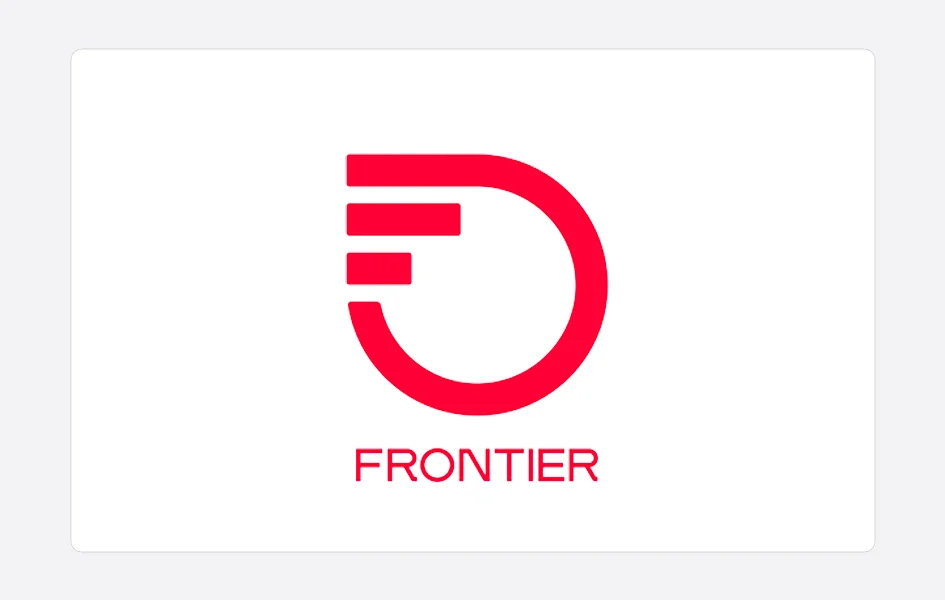
Frontier Communications offers a 2-gigabit service in its fiber markets but continues to sell DSL in more rural areas without fiber today and may never have it. DSL download speeds typically range from 6 Mbps to 115 Mbps, but customers living too far from the nearest phone network office may experience slower speeds.
Price: $50 – $155 per month
Speeds: 500 – 5,000Mbps
Key Info: Unlimited data, no contracts, no equipment fee
2. AT&T
AT&T is first on our list of best DSL providers in 2024. It is the world’s largest telecommunications provider and third-largest Internet Service Provider (ISP).
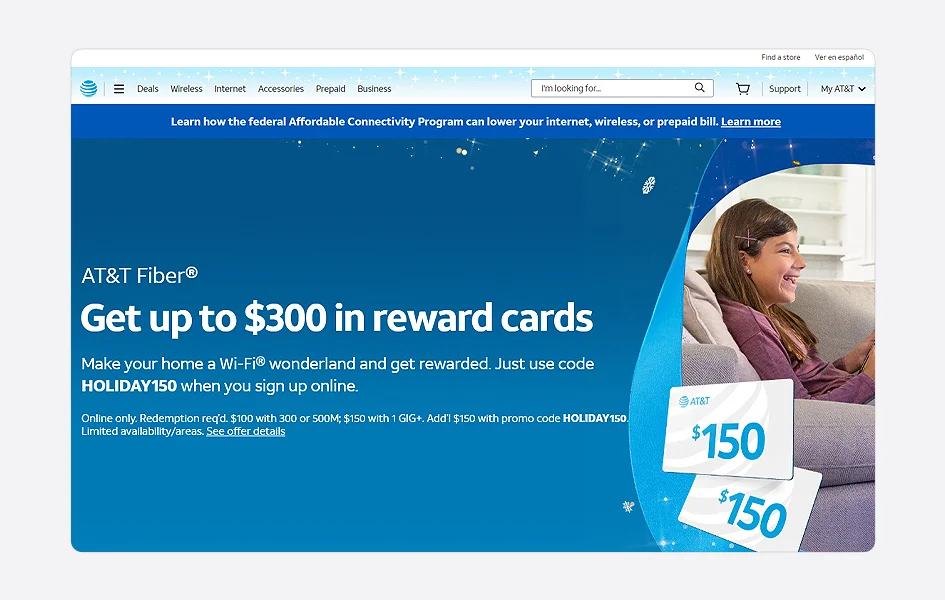
It began phasing out its DSL (Digital Subscriber Line) service in 2020. As a result of this expansion, AT&T now plans to provide fiber internet access in 90 major metropolitan areas to more than 3 million additional households.
Price: $55 per month
Speeds: 10 – 100Mbps
Key Info: 1TB monthly data allowance, no contracts
3. Verizon
Verizon Wireless network is one of the best DSL providers, offering Verizon Fios, a fiber-optic network that offers fast download and upload speeds.

Fios fiber optic internet and television service is widely available throughout the Northeast U.S. Fixed mobile (LTE or 5G), DSL, or fiber optic Internet service are available depending on location.
Price: $74.99 per month
Speed: speeds up to 140Mbps
Key Info: for 1 year plus taxes, equip. charges & other fees
4. CenturyLink
CenturyLink is another best DSL providers we have on our list. It offers fast DSL internet without annual contracts, promotional rates that expire after a few months, bundles, or data overage charges.
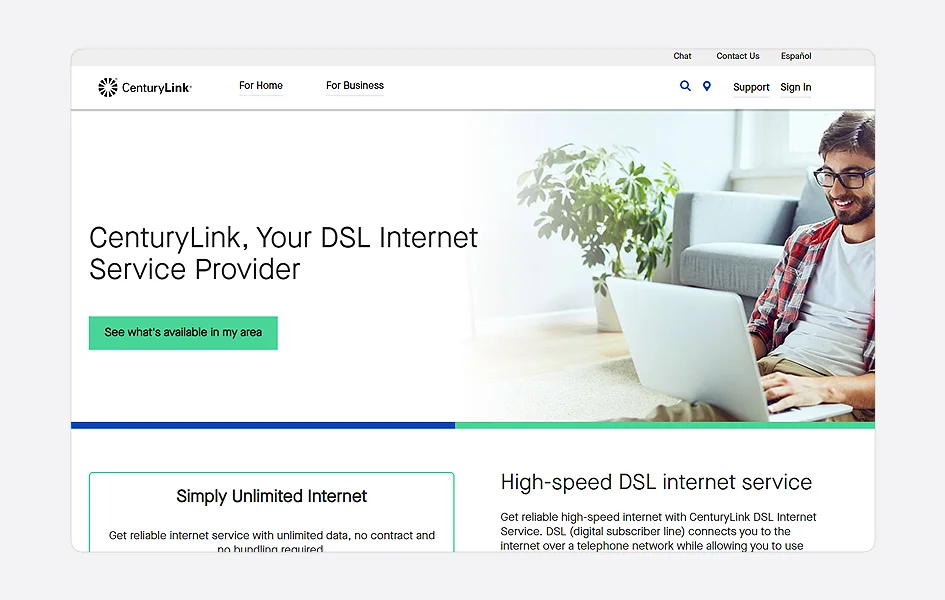
It has a reliable network performance that is good for home internet. CenturyLink might be the right option if you are looking for a tried-and-true internet provider. It is best for ISPs in Rural Areas, tt DSL, and Fiber
Prices: $55 per month
Speeds: 10 – 140Mbps
Key Info: Unlimited data, no contracts
5. Kinetic
Kinetic is one of the leading providers of broadband speeds through DSL. It mainly focuses on DSL internet rather than other types of internet services.
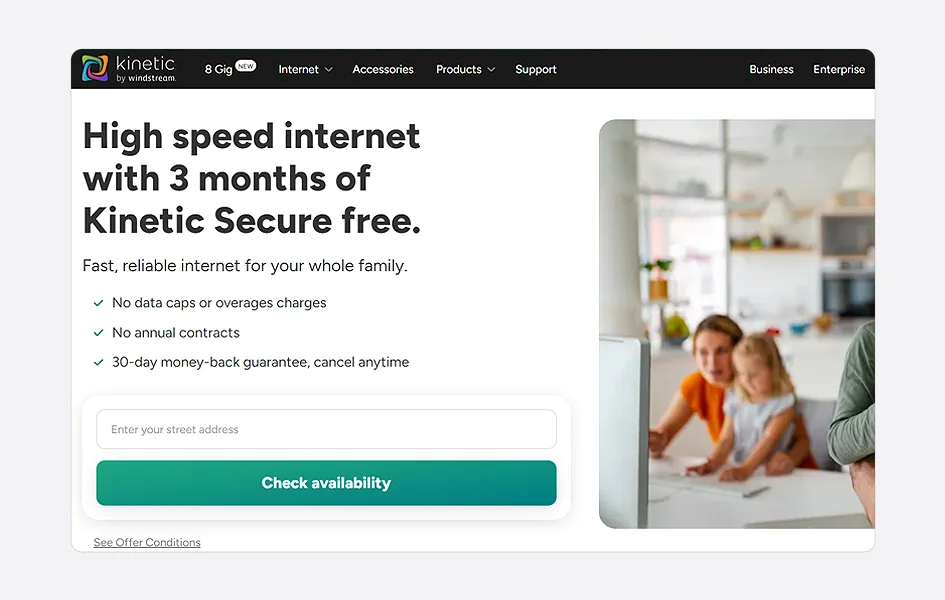
According to a review on CNET, “Kinetic is considerably faster than most DSL providers, with speeds of 100Mbps or higher available throughout 64% of service areas.
Price: $40 – $70 per month
Speed: 100 – 1,000Mbps
Key Info: Unlimited data, no contracts
Tips for Choosing the Best DSL Internet Plan
Here are some factors you should consider while choosing the best DSL internet plan
- Assess your internet needs: This is where you will determine the speed, data allowance, and reliability you need for your online activities like streaming, gaming, and browsing
- Compare providers: Research different DSL providers in your area. Compare their plan, price, and customer reviews to find what suits you best.
- Look for contract terms and pricing: Consider how long the contract is, whether there are any early termination fees, or if there are any promotional prices. Beware of possible price hikes after an introductory period
- Evaluate data caps and unlimited usage: Some DSL plans may have a certain amount of data that can be used, while others give unlimited access to information. If you use the web a lot, it would be wise to go with an unlimited data plan so as to avoid incurring any more charges.
- Consider customer support and reliability: A prompt and dependable customer support system becomes essential when experiencing technical problems or needing assistance.
- Check availability of other internet types: In case DSL is not available or unsuitable for your needs, check out other alternatives such as cable, fiber, or satellite.
Conclusion
In conclusion, DSL Internet is a game-changer in the world of connectivity, and understanding how it works is crucial in maximizing your online experience. We’ve explored the ins and outs of DSL, from its underlying technology to its incredible benefits.
You can choose any provider from the above top 5 as your reliable DSL provider. They are best in terms of speed, reliability, and pricing.
Say goodbye to sluggish downloads, never-ending buffering, and frustrating delays with the help of DSL. As a result, you’ll be able to stream uninterrupted, navigate websites effortlessly, and get more done with more efficiency.
FAQs
How to check the test speed of DSL Internet?
Several websites and apps are available to check the test speed of DSL internet. Some of them are:
- Speed.io
- Speedtest.net
- Fast.com
- Google Speed Test
You can also find other websites to test the speed of your DSL internet. You can visit their website, click on test, and all the information, such as speed ping jitter will be displayed.
How much does a DSL internet cost to install at home?
The price of setting up DSL internet in your residence may fluctuate depending on various aspects, including geographical location, the chosen service provider, and the particular package you opt for. However, the monthly cost of DSL internet ranges from $40 – $75 per month.
What is the importance of DSL internet?
Many factors make DSL a widely used and valued internet connection method. Some of them are:
- Broadband Access
- Widespread Availability
- Cost-Effectiveness
- Stability and reliability
- Compatibility with Phone Lines
- Decent upload and download speed
Is Cable internet service better than DSL internet service?
According to speed, cable internet is better than DSL internet service, but according to its availability and cost-effectiveness, DSL is better.
Is 4G Internet faster than DSL Internet?
Yes, 4G Internet is faster than DSL Internet. Compared to DSL, 4G typically offers higher download speeds of up to over 100 megabits per second (Mbps). Speed depends on network conditions, technology, and distance from the service provider.
Is DSL internet best for gaming purposes?
Yes, DSL is good for gaming purposes. Although fiber-optic cable provides higher speeds, you may wish to consider DSL internet rather than wireless connections when playing games.

